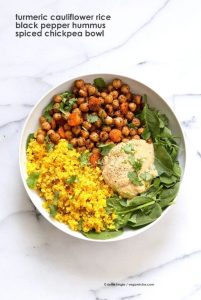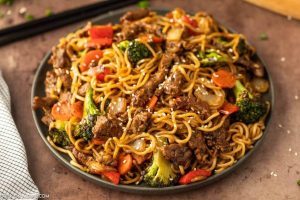Oh, the sizzle of hibachi noodles on a hot grill is enough to make anyone’s mouth water! Whether you’re whipping up a quick weeknight dinner, hosting a festive gathering, or simply craving some comfort food with a twist, our roundup of 18 delicious hibachi noodle recipes has got you covered. Dive in and discover your next favorite dish that’s sure to impress at any occasion!
Classic Hibachi Noodles with Vegetables
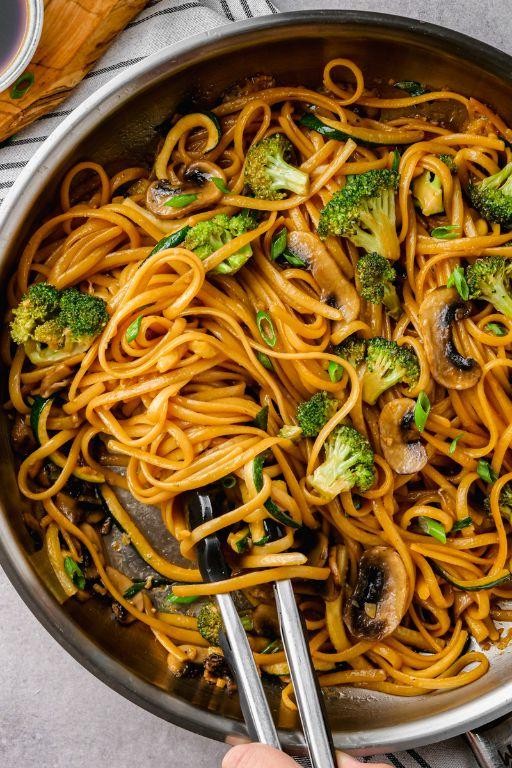
Gently, the sizzle of the pan brings back memories of bustling hibachi grills, where the art of cooking is as much a performance as it is a meal. Today, we’re bringing that experience home with a dish that’s both comforting and vibrant, a canvas of noodles and vegetables painted with the flavors of soy and sesame.
Ingredients
- 8 oz dried udon noodles – their chewy texture is unbeatable for hibachi.
- 2 tbsp sesame oil – it’s the soul of the dish, toasting lightly for depth.
- 1 tbsp extra virgin olive oil – my go-to for sautéing, adding a subtle fruitiness.
- 2 cups mixed vegetables (bell peppers, onions, zucchini) – sliced thin for quick cooking.
- 3 tbsp soy sauce – I reach for low-sodium to control the saltiness.
- 1 tbsp garlic, minced – because everything’s better with garlic.
- 1 tsp ginger, grated – fresh is best, it brightens the whole dish.
- 1 tbsp butter – a pat adds richness, melting into the noodles beautifully.
Instructions
- Bring a large pot of water to a rolling boil and cook the udon noodles according to package instructions, usually about 8-10 minutes, then drain and set aside.
- Heat a large skillet or wok over medium-high heat and add the sesame and olive oils, swirling to coat the pan.
- Add the minced garlic and grated ginger, stirring for 30 seconds until fragrant – this is where the flavor foundation is built.
- Toss in the mixed vegetables, stirring frequently for 4-5 minutes until they’re just tender but still crisp.
- Push the vegetables to one side of the pan, add the cooked noodles to the other, and drizzle with soy sauce, tossing to combine everything evenly.
- Let the noodles sit undisturbed for a minute to get a slight crisp on the bottom, then stir in the butter until it’s fully melted and coats the noodles.
Lightly, the dish comes together with a harmony of textures – the noodles are springy, the vegetables retain a bite, and the buttery soy glaze ties it all together. Serve it straight from the skillet for that authentic hibachi feel, or top with a sprinkle of sesame seeds for extra crunch.
Spicy Garlic Hibachi Noodles

As the evening light fades, there’s something deeply comforting about stirring together a dish that’s both vibrant and full of flavor, like these Spicy Garlic Hibachi Noodles. It’s a recipe that feels like a warm embrace, with just the right kick to awaken the senses.
Ingredients
- 8 oz spaghetti noodles (I find that thin spaghetti works best here, clinging to every bit of sauce)
- 2 tbsp extra virgin olive oil (my kitchen staple for its fruity notes)
- 4 cloves garlic, minced (freshly minced garlic makes all the difference)
- 1 tbsp red pepper flakes (adjust according to your heat preference)
- 2 tbsp soy sauce (I opt for low-sodium to control the saltiness)
- 1 tbsp honey (for that perfect balance of sweet and spicy)
- 1 tbsp butter (unsalted, to let the other flavors shine)
- 1/4 cup green onions, sliced (for a fresh, crisp finish)
Instructions
- Bring a large pot of salted water to a boil over high heat. Add the spaghetti noodles and cook for 8-10 minutes, until al dente. Tip: Stir occasionally to prevent sticking.
- While the noodles cook, heat the olive oil in a large skillet over medium heat. Add the minced garlic and red pepper flakes, sautéing for 1-2 minutes until fragrant. Tip: Keep the heat medium to avoid burning the garlic.
- Drain the noodles, reserving 1/4 cup of the pasta water. Add the noodles to the skillet with the garlic and pepper flakes.
- Pour in the soy sauce, honey, and reserved pasta water. Toss everything together until the noodles are evenly coated. Tip: The pasta water helps create a silky sauce that clings to the noodles.
- Finish by stirring in the butter until melted and the noodles are glossy. Garnish with sliced green onions.
On the plate, these noodles are a tangle of glossy, spicy strands, with the garlic and honey playing off each other beautifully. Serve them straight from the skillet for a cozy, communal meal, or top with a fried egg for an extra layer of richness.
Hibachi Noodles with Shrimp and Scallops
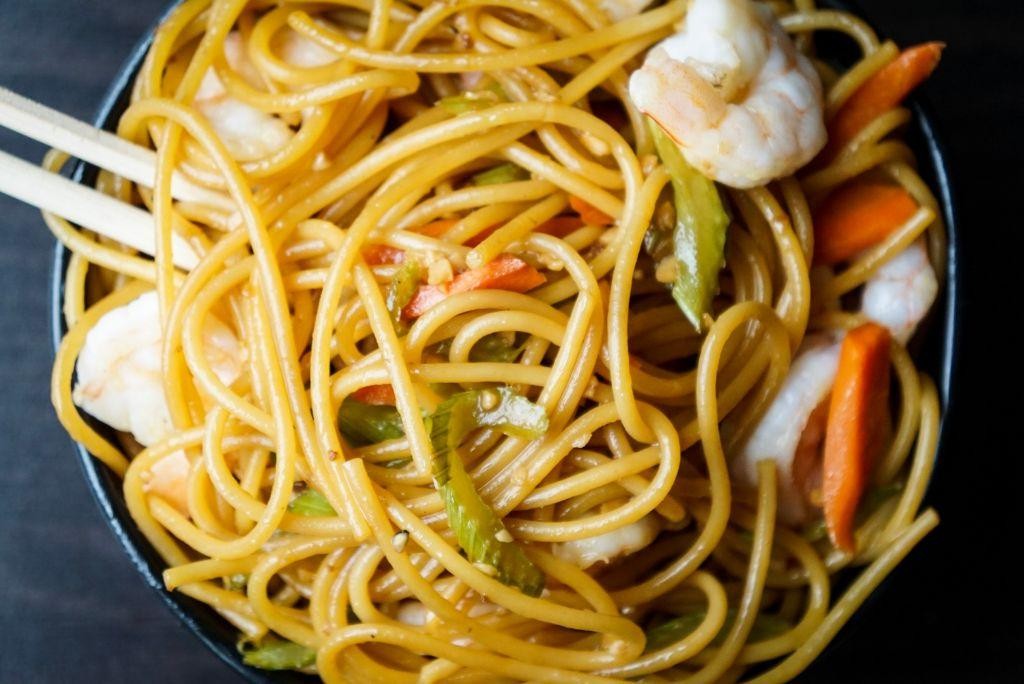
Mornings like this, when the light filters through the kitchen window just so, I find myself drawn to the simplicity and comfort of cooking something that feels both luxurious and homely. Hibachi noodles with shrimp and scallops is that dish for me, a melody of textures and flavors that sings of quiet evenings and satisfied sighs.
Ingredients
- 8 oz hibachi noodles – I love the chewiness they bring to the dish.
- 1/2 lb shrimp, peeled and deveined – Fresh is best, but frozen works in a pinch.
- 1/2 lb scallops – Look for dry-packed; they sear beautifully.
- 2 tbsp extra virgin olive oil – My go-to for its fruity notes.
- 1 tbsp soy sauce – For that umami depth.
- 1 tsp garlic, minced – Because what’s a stir-fry without garlic?
- 1/2 tsp ginger, grated – Adds a lovely warmth.
- 1/4 cup green onions, sliced – For a pop of color and crunch.
Instructions
- Bring a large pot of water to a boil and cook the hibachi noodles according to package instructions, usually about 3-4 minutes. Tip: Stir occasionally to prevent sticking.
- While the noodles cook, heat the olive oil in a large skillet over medium-high heat until shimmering, about 2 minutes.
- Add the shrimp and scallops to the skillet, seasoning lightly with salt. Cook for 2 minutes per side, just until they start to turn opaque. Tip: Don’t overcrowd the pan to ensure a good sear.
- Remove the seafood from the skillet and set aside. In the same skillet, add the garlic and ginger, sautéing for about 30 seconds until fragrant.
- Drain the noodles and add them to the skillet along with the soy sauce, tossing to combine everything well. Tip: A pair of tongs works great for this.
- Return the shrimp and scallops to the skillet, adding the green onions. Toss everything together for another minute to heat through.
Now, the dish comes together with the noodles perfectly al dente, the seafood tender and sweet, and the whole thing laced with the subtle heat of ginger and the depth of soy. Serve it straight from the skillet for that authentic hibachi feel, or plate it up with a sprinkle of extra green onions for a touch of elegance.
Vegetarian Hibachi Noodles with Tofu
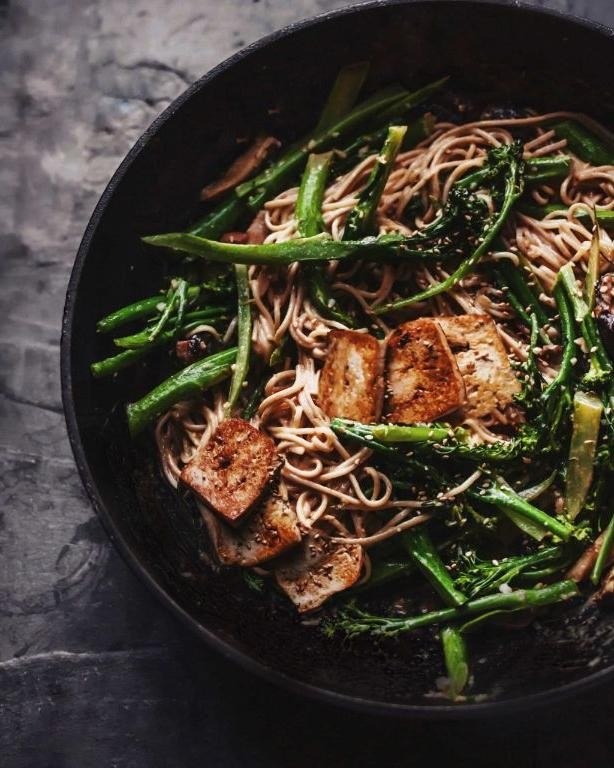
How quietly the evening settles in, the perfect time to stir up something comforting yet vibrant, like these Vegetarian Hibachi Noodles with Tofu. It’s a dish that dances between simplicity and flavor, a gentle reminder of the joy found in cooking with intention.
Ingredients
- 8 oz. of udon noodles (I love their chewy texture, it’s like biting into little clouds)
- 14 oz. firm tofu, pressed and cubed (pressing it removes excess water, making it crispier)
- 2 tbsp extra virgin olive oil (my kitchen staple for its fruity notes)
- 1 cup sliced mushrooms (they add an earthy depth that’s irresistible)
- 1 bell pepper, thinly sliced (for a sweet crunch)
- 2 tbsp soy sauce (I opt for low-sodium to control the saltiness)
- 1 tbsp sesame oil (that nutty aroma is everything)
- 1 tsp garlic, minced (because what’s a stir-fry without garlic?)
- 1 tsp ginger, grated (fresh ginger brings a zing that powdered just can’t match)
- 2 green onions, sliced (for a fresh finish)
Instructions
- Bring a large pot of water to a boil and cook the udon noodles according to package instructions, usually about 8-10 minutes. Drain and set aside.
- Heat the olive oil in a large skillet over medium-high heat. Add the tofu cubes and cook until golden brown on all sides, about 5-7 minutes. Tip: Don’t stir too often to let them crisp up nicely.
- Add the mushrooms and bell pepper to the skillet. Stir-fry for about 3-4 minutes until they start to soften.
- Lower the heat to medium and add the soy sauce, sesame oil, garlic, and ginger. Stir well to coat everything evenly, cooking for another 2 minutes. Tip: Keep the heat moderate to prevent the garlic from burning.
- Toss in the cooked noodles and green onions, mixing gently until everything is well combined and heated through, about 2 minutes. Tip: Use tongs for easier mixing and to keep the noodles intact.
Gently twirl your fork into the noodles, and you’ll find each bite a harmonious blend of textures—the chewiness of the udon, the crispness of the tofu, and the softness of the veggies. Serve it with a sprinkle of sesame seeds or a dash of sriracha for an extra kick, turning a simple meal into a celebration of flavors.
Beef Hibachi Noodles with Mushrooms
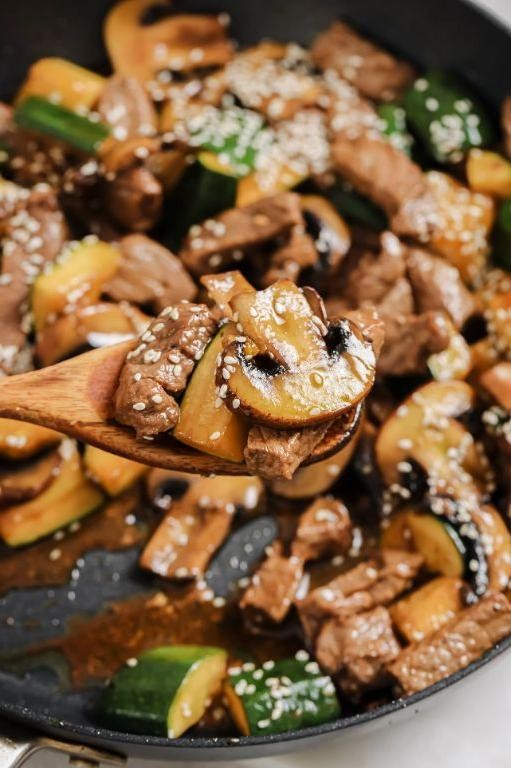
Zesty yet comforting, this dish brings the vibrant energy of a hibachi grill right into your kitchen. It’s a melody of savory beef, earthy mushrooms, and tender noodles, all dancing together in a lightly seasoned sauce.
Ingredients
- 8 oz beef sirloin, thinly sliced (I find freezing the beef for 20 minutes makes slicing easier)
- 2 cups shiitake mushrooms, sliced (their meaty texture is perfect here)
- 4 oz hibachi noodles (or substitute with udon if you’re in a pinch)
- 2 tbsp soy sauce (I swear by the low-sodium version for better control)
- 1 tbsp sesame oil (toasted, for that deep, nutty flavor)
- 1 tbsp vegetable oil (for high-heat cooking)
- 2 cloves garlic, minced (fresh is non-negotiable for me)
- 1 tsp ginger, grated (keep the rest in the freezer for next time)
- 1/2 cup green onions, sliced (for a pop of color and crunch)
Instructions
- Heat a large skillet or wok over medium-high heat and add 1 tbsp of vegetable oil.
- Once the oil shimmers, add the beef slices in a single layer. Cook for 2 minutes per side until just browned, then remove and set aside.
- In the same skillet, add the remaining 1 tbsp of vegetable oil and the mushrooms. Cook for 4 minutes, stirring occasionally, until they start to golden.
- Push the mushrooms to one side, add the garlic and ginger to the cleared space, and sauté for 30 seconds until fragrant.
- Add the noodles to the skillet along with 1/4 cup of water. Cover and let steam for 3 minutes to soften.
- Uncover, stir in the soy sauce and sesame oil, then return the beef to the skillet. Toss everything together and cook for another 2 minutes to heat through.
- Garnish with green onions before serving.
This dish sings with the harmony of textures—the chew of the noodles, the tenderness of the beef, and the slight resistance of the mushrooms. Try serving it with a sprinkle of sesame seeds or a side of pickled ginger to elevate the experience.
Chicken Hibachi Noodles with Zucchini
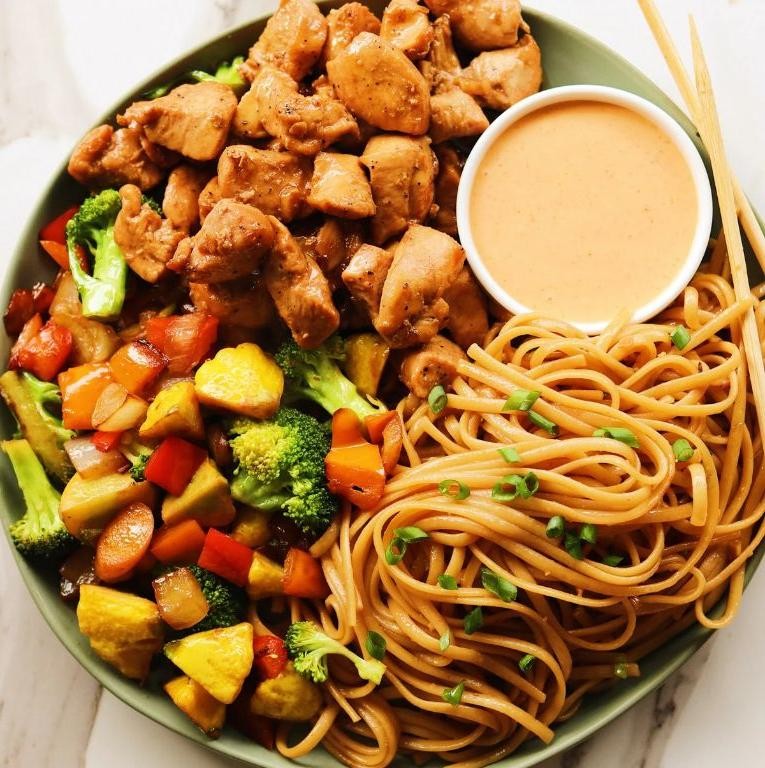
Many evenings, I find myself craving something that’s both comforting and a little adventurous, a dish that bridges the gap between the familiar and the novel. That’s when I turn to this Chicken Hibachi Noodles with Zucchini recipe, a dish that’s as fun to make as it is to eat.
Ingredients
- 2 boneless, skinless chicken breasts, sliced into thin strips (I find that slightly freezing them for 10 minutes makes slicing easier.)
- 8 oz. hibachi-style noodles (These can be found in the Asian aisle of most supermarkets, but if you’re in a pinch, spaghetti works too.)
- 2 medium zucchinis, julienned (I love the texture they add, slightly crisp yet tender.)
- 2 tbsp extra virgin olive oil (My go-to for its fruity notes.)
- 3 tbsp soy sauce (I opt for low-sodium to control the saltiness.)
- 1 tbsp sesame oil (It adds a nutty depth that’s irreplaceable.)
- 2 cloves garlic, minced (Fresh is best here for that sharp, aromatic kick.)
- 1 tsp ginger, grated (A little goes a long way in brightening the dish.)
- 1 tbsp butter (Unsalted, because I like to manage the seasoning myself.)
Instructions
- Bring a large pot of water to a boil over high heat. Add the hibachi noodles and cook according to package instructions, usually about 4-5 minutes, until al dente. Drain and set aside.
- While the noodles cook, heat 1 tbsp of olive oil in a large skillet over medium-high heat. Add the chicken strips and cook for 5-6 minutes, until no longer pink. Remove from the skillet and set aside.
- In the same skillet, add the remaining 1 tbsp of olive oil. Sauté the zucchini for 3-4 minutes, until just tender but still crisp. Tip: Don’t overcrowd the skillet to ensure they get a nice sear.
- Lower the heat to medium and add the garlic and ginger to the skillet, cooking for about 30 seconds until fragrant. Tip: Keep stirring to prevent burning.
- Return the chicken to the skillet, along with the cooked noodles. Add the soy sauce and sesame oil, tossing everything together until well combined. Tip: Use tongs for easier mixing.
- Finish by stirring in the butter until melted, which adds a rich gloss to the noodles.
Just like that, you’ve got a dish where the noodles are perfectly slick with sauce, the chicken is tender, and the zucchini adds a fresh crunch. Serve it straight from the skillet for a rustic touch, or plate it up with a sprinkle of sesame seeds for a bit of elegance.
Hibachi Noodles with Lobster Tail
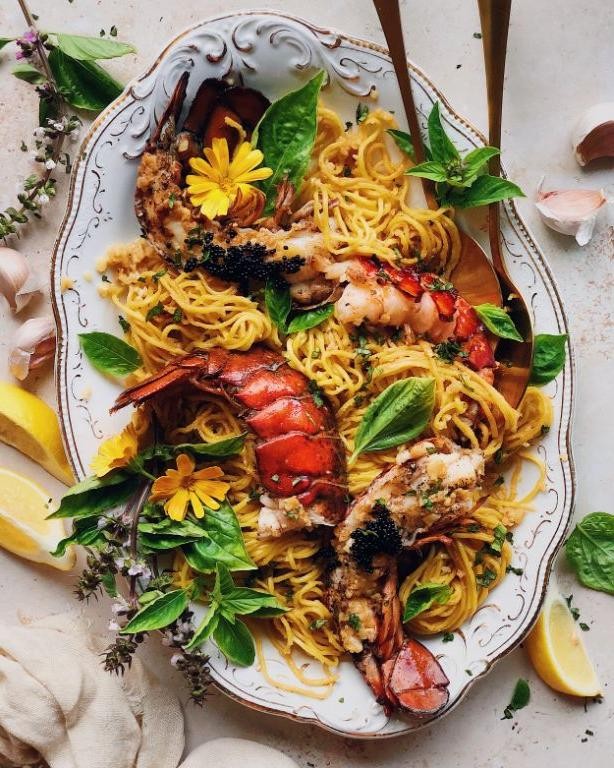
Wandering through the flavors of the sea and the comfort of noodles, this dish brings a luxurious twist to your weeknight dinner. It’s a celebration of textures, where the succulence of lobster meets the tender bite of hibachi noodles.
Ingredients
- 8 oz lobster tail (fresh or thawed, the sweetness is unmatched)
- 8 oz hibachi noodles (I love the slight chewiness they offer)
- 2 tbsp unsalted butter (for that rich, velvety finish)
- 1 tbsp extra virgin olive oil (my go-to for a fruity note)
- 2 cloves garlic, minced (freshly minced makes all the difference)
- 1 tbsp soy sauce (for that umami depth)
- 1 tsp sesame oil (a little goes a long way for aroma)
- 1/4 cup green onions, sliced (for a crisp, colorful garnish)
- Salt to taste (I prefer sea salt for its clean flavor)
Instructions
- Bring a large pot of salted water to a boil over high heat. Add the hibachi noodles and cook according to package instructions, usually about 3-4 minutes, until al dente. Drain and set aside.
- While the noodles cook, heat the olive oil in a large skillet over medium heat. Add the minced garlic and sauté for about 30 seconds, until fragrant but not browned.
- Add the lobster tail to the skillet. Cook for about 2 minutes on each side, until the shell turns bright red and the meat is opaque.
- Remove the lobster from the skillet and set aside to cool slightly. Once cool enough to handle, remove the meat from the shell and chop into bite-sized pieces.
- Return the skillet to medium heat and add the butter. Once melted, add the cooked noodles, soy sauce, and sesame oil. Toss to combine and heat through, about 2 minutes.
- Add the chopped lobster back to the skillet, gently folding it into the noodles to warm through, about 1 minute.
- Garnish with sliced green onions before serving.
Perfectly balanced, the dish offers a melody of flavors with the lobster’s sweetness shining through the savory noodles. Serve it on a warm plate to keep the noodles tender and the lobster succulent, perhaps with a side of steamed vegetables for a complete meal.
Sweet and Sour Hibachi Noodles
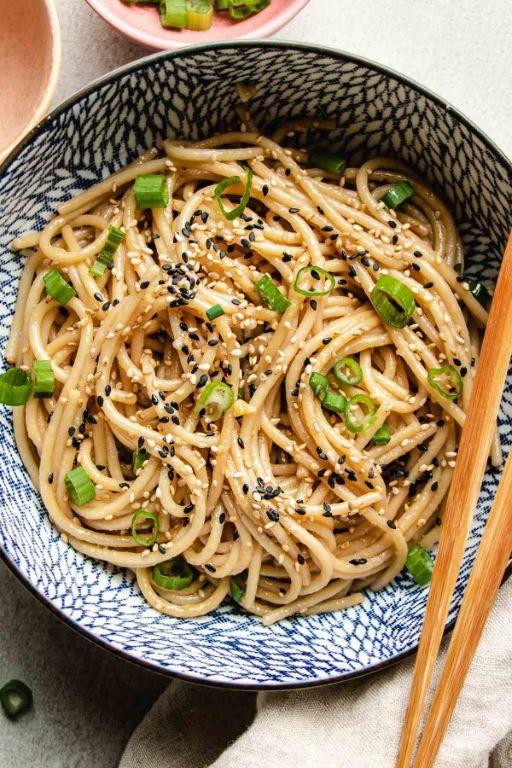
Gently stirring the wok, the aroma of sweet and sour hibachi noodles fills the kitchen, a comforting reminder of the simple joys in life. This dish, with its vibrant colors and tangy sweetness, is a testament to the beauty of combining simple ingredients with care.
Ingredients
- 8 oz hibachi noodles – I find the slightly thicker texture holds up better to the sauce.
- 2 tbsp extra virgin olive oil – my go-to for its fruity notes.
- 1 cup bell peppers, thinly sliced – a mix of colors adds visual appeal.
- 1/2 cup pineapple chunks – fresh is best, but canned works in a pinch.
- 1/4 cup soy sauce – low sodium to control the saltiness.
- 2 tbsp honey – for that perfect balance of sweetness.
- 1 tbsp rice vinegar – adds a subtle tang.
- 1 tsp ginger, minced – fresh ginger makes all the difference.
- 2 cloves garlic, minced – because garlic is life.
- 1/2 tsp red pepper flakes – adjust to your heat preference.
Instructions
- Bring a large pot of water to a boil and cook the hibachi noodles according to package instructions, usually about 4-5 minutes. Tip: Stir occasionally to prevent sticking.
- While the noodles cook, heat the olive oil in a large wok or skillet over medium-high heat.
- Add the bell peppers and pineapple to the wok, sautéing for about 3 minutes until slightly softened. Tip: Keep the veggies crisp for texture.
- In a small bowl, whisk together the soy sauce, honey, rice vinegar, ginger, garlic, and red pepper flakes.
- Drain the noodles and add them to the wok with the vegetables.
- Pour the sauce over the noodles and vegetables, tossing everything together to coat evenly. Cook for an additional 2 minutes, allowing the flavors to meld. Tip: If the sauce thickens too much, a splash of water can loosen it.
Relishing each bite, the noodles offer a delightful chew, while the sauce clings perfectly, offering bursts of sweet, sour, and spicy. Serve it topped with a sprinkle of sesame seeds or alongside a crisp cucumber salad for a refreshing contrast.
Hibachi Noodles with Pineapple and Pork
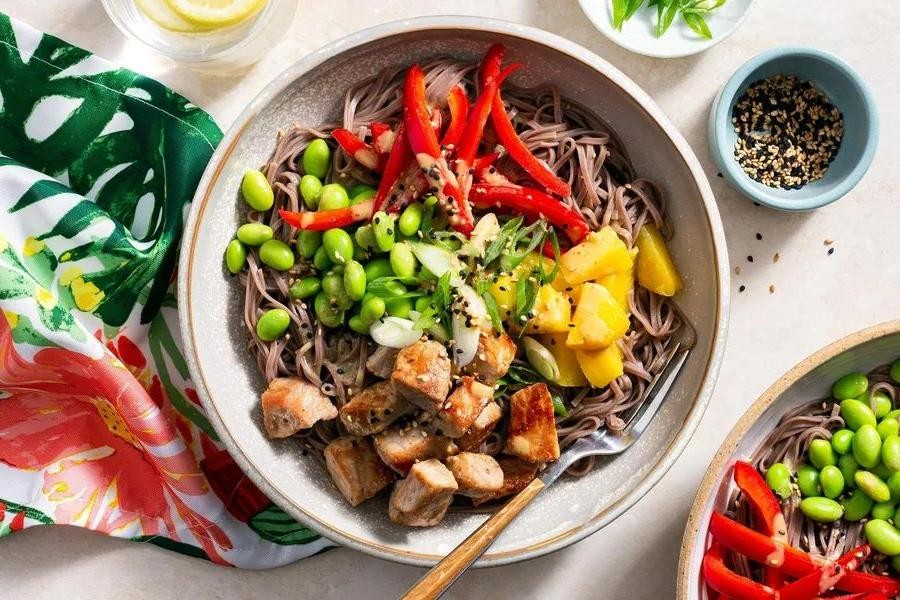
Sometimes, the most comforting meals come from the simplest combinations, like the sweet and savory dance of pineapple and pork in these Hibachi Noodles. It’s a dish that feels like a warm hug, perfect for those evenings when you crave something both familiar and exciting.
Ingredients
- 8 oz thin spaghetti – I find that the thinner the noodle, the better it soaks up the sauce.
- 1 tbsp extra virgin olive oil – my go-to for its fruity notes.
- 1 lb pork tenderloin, thinly sliced – ensures quick and even cooking.
- 1 cup fresh pineapple chunks – the sweetness is a game-changer.
- 2 tbsp soy sauce – for that umami depth.
- 1 tbsp honey – just a touch to balance the flavors.
- 2 cloves garlic, minced – because everything’s better with garlic.
- 1 tsp ginger, grated – adds a nice zing.
- 1/2 cup green onions, sliced – for a pop of color and freshness.
Instructions
- Bring a large pot of salted water to a boil over high heat. Add the spaghetti and cook according to package instructions until al dente, about 8 minutes. Tip: Stir occasionally to prevent sticking.
- While the pasta cooks, heat the olive oil in a large skillet over medium-high heat. Add the pork slices and cook until no longer pink, about 3-4 minutes per side. Tip: Don’t overcrowd the pan to ensure a good sear.
- Add the pineapple chunks to the skillet with the pork and cook for another 2 minutes, until the pineapple starts to caramelize.
- In a small bowl, whisk together the soy sauce, honey, garlic, and ginger. Pour this mixture over the pork and pineapple, stirring to coat everything evenly. Cook for 1 minute more.
- Drain the spaghetti and add it directly to the skillet. Toss everything together until the noodles are well coated with the sauce. Tip: A pair of tongs works best for this.
- Garnish with green onions before serving.
Every bite of this dish offers a delightful contrast between the tender pork, the juicy pineapple, and the chewy noodles. Serve it straight from the skillet for a rustic, family-style meal that’s sure to impress.
Low Carb Hibachi Noodles with Shirataki
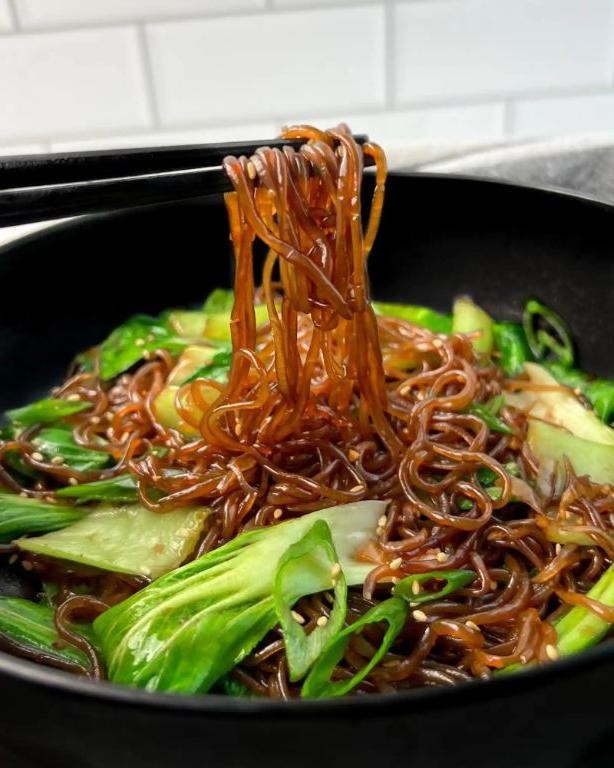
Evenings like these call for something light yet satisfying, a dish that dances between comfort and health without missing a beat. Low carb hibachi noodles with shirataki offer just that, a gentle nod to traditional flavors while keeping things light on the carbs.
Ingredients
- 1 package shirataki noodles (I always rinse these thoroughly to remove any lingering aroma)
- 2 tbsp avocado oil (its high smoke point makes it perfect for stir-frying)
- 1 cup sliced mushrooms (cremini are my favorite for their earthy depth)
- 1/2 cup diced onions (yellow onions bring a sweet sharpness that I adore)
- 2 cloves garlic, minced (freshly minced garlic is non-negotiable for me)
- 1 tbsp soy sauce (I opt for low-sodium to control the saltiness)
- 1 tsp sesame oil (a little goes a long way in adding that nutty aroma)
- 2 eggs (room temperature eggs blend more smoothly into the noodles)
- Salt and pepper (just a pinch to season)
Instructions
- Begin by draining and rinsing the shirataki noodles under cold water for 2 minutes to remove any off-putting smell.
- Heat a large skillet over medium-high heat and add the avocado oil, swirling to coat the pan evenly.
- Add the sliced mushrooms and diced onions to the skillet, sautéing for about 5 minutes until they start to soften and brown slightly.
- Stir in the minced garlic and cook for another 30 seconds, just until fragrant—be careful not to burn it.
- Push the vegetables to one side of the skillet and pour the beaten eggs into the other side, scrambling them until just set.
- Add the rinsed shirataki noodles to the skillet, tossing everything together gently to combine.
- Drizzle the soy sauce and sesame oil over the noodles, stirring well to ensure every strand is coated.
- Season with a pinch of salt and pepper, then give it one final toss to mix everything thoroughly.
- Cook for an additional 2 minutes, allowing the flavors to meld together beautifully.
Best enjoyed straight from the skillet, these noodles offer a delightful chewiness, with the mushrooms and onions adding a savory depth that’s hard to resist. For an extra touch, sprinkle some green onions on top or serve with a side of spicy mayo to dip.
Hibachi Noodles with Duck and Green Onions
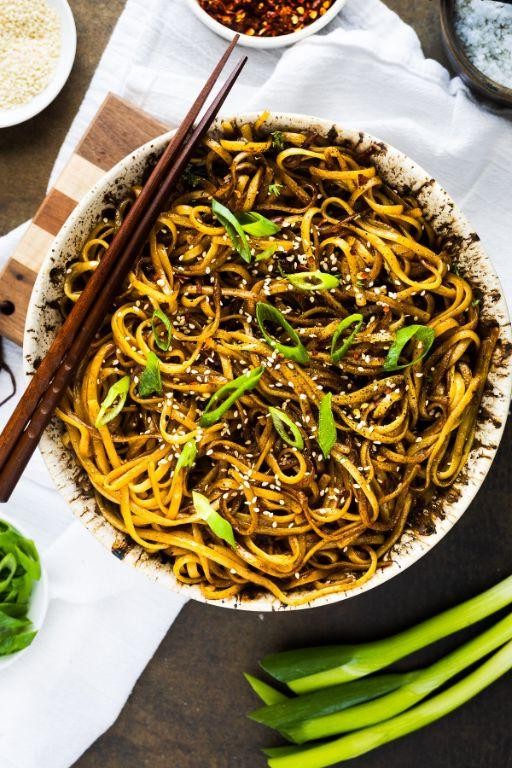
Flickering through the memories of my last visit to a bustling hibachi grill, the sizzle of noodles and the rich aroma of duck linger in my mind. Today, I’m bringing that experience into my kitchen, with a dish that’s as much about the process as it is about the flavors.
Ingredients
- 8 oz duck breast, skin on (the crispier, the better)
- 2 cups hibachi-style noodles (I find the fresh ones at my local Asian market work wonders)
- 3 green onions, sliced diagonally (for that elegant touch)
- 2 tbsp soy sauce (I swear by the low-sodium version for better control)
- 1 tbsp sesame oil (toasted, for depth)
- 1 tsp ginger, minced (fresh is non-negotiable here)
- 1 garlic clove, minced (because what’s a stir-fry without it?)
- 1 tbsp vegetable oil (for that high-heat sear)
Instructions
- Heat a large skillet over medium-high heat and add vegetable oil, swirling to coat.
- Season the duck breast with salt and pepper, then place skin-side down in the skillet. Cook for 5 minutes until the skin is golden and crispy.
- Flip the duck and cook for another 4 minutes for medium-rare. Remove from skillet and let rest.
- In the same skillet, add a bit more oil if needed, then toss in the ginger and garlic, stirring for 30 seconds until fragrant.
- Add the noodles and soy sauce, tossing to coat evenly. Cook for 2 minutes, letting the noodles soak up the flavors.
- Slice the duck thinly against the grain and add to the noodles along with green onions. Drizzle with sesame oil and give it one final toss.
- Serve immediately, garnishing with extra green onions if desired.
As you take the first bite, the tender duck and springy noodles dance together, with the green onions adding a fresh crunch. This dish shines when served straight from the skillet, the steam carrying the promise of comfort.
Gluten-Free Hibachi Noodles with Tamari
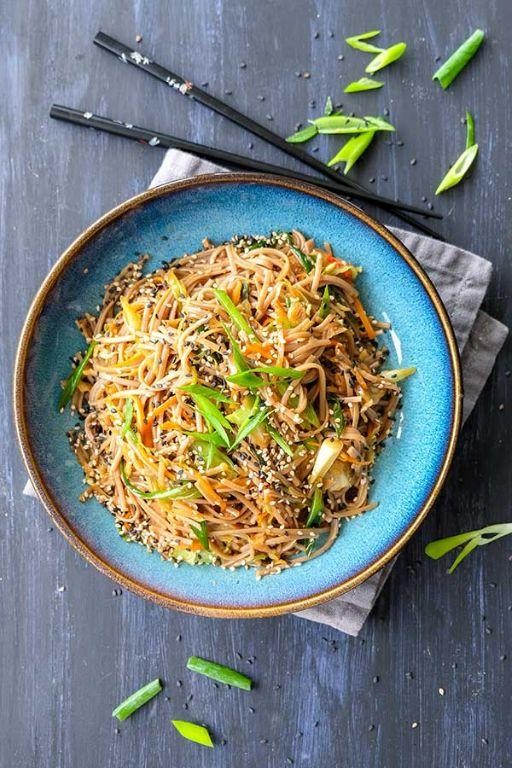
Calmly, as the morning light filters through the kitchen window, I find myself drawn to the simplicity and warmth of cooking. Today, it’s about creating something that feels both nourishing and indulgent—a dish that bridges the gap between healthful eating and the comfort of familiar flavors.
Ingredients
- 8 oz gluten-free spaghetti (I love the texture of brown rice noodles for this recipe)
- 2 tbsp extra virgin olive oil (my kitchen staple for its fruity notes)
- 1 cup sliced mushrooms (cremini add a lovely earthiness)
- 1 medium zucchini, julienned (for a crisp contrast)
- 1 large carrot, julienned (a sweet crunch is essential)
- 2 cloves garlic, minced (freshly minced makes all the difference)
- 3 tbsp tamari (a gluten-free soy sauce alternative with depth)
- 1 tbsp honey (just a touch to balance the flavors)
- 1 tsp sesame oil (for that unmistakable aroma)
- 2 green onions, sliced (for a fresh finish)
Instructions
- Bring a large pot of salted water to a boil over high heat. Tip: Salting the water well is key to flavoring the noodles from the start.
- Add the gluten-free spaghetti and cook according to package instructions, usually about 8-10 minutes, until al dente. Tip: Stir occasionally to prevent sticking.
- While the noodles cook, heat the olive oil in a large skillet over medium heat. Add the mushrooms, zucchini, and carrot, sautéing for about 5 minutes until just tender.
- Add the minced garlic to the skillet and cook for another 30 seconds, until fragrant. Tip: Be careful not to burn the garlic to keep the flavor sweet.
- Drain the noodles and add them to the skillet with the vegetables. Pour in the tamari, honey, and sesame oil, tossing everything together until well combined and heated through, about 2 minutes.
- Garnish with sliced green onions before serving.
Just like that, you’re left with a dish that’s a harmony of textures—the noodles tender yet firm, the vegetables crisp-tender, and the sauce clinging just right. Serve it with a sprinkle of sesame seeds for an extra nutty crunch, or alongside a simple cucumber salad for a refreshing contrast.
Hibachi Noodles with Salmon and Asparagus
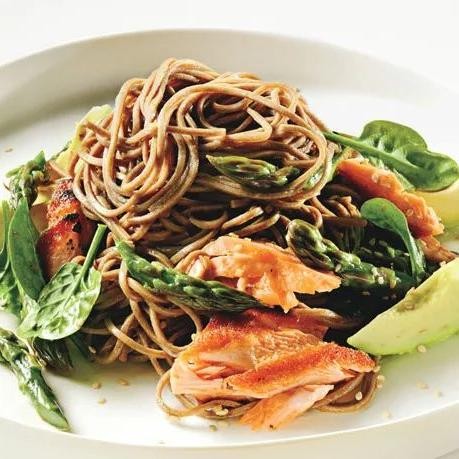
Reflecting on the quiet of the morning, I find myself drawn to the simplicity and warmth of cooking, especially when it involves the vibrant colors and textures of Hibachi Noodles with Salmon and Asparagus. It’s a dish that feels both nourishing and indulgent, a perfect balance for those moments when you’re cooking just for yourself or sharing with someone special.
Ingredients
- 8 oz salmon fillet, skin-on (I love the crispiness the skin adds when seared)
- 2 cups asparagus, trimmed and cut into 2-inch pieces (the fresher, the better—listen for that snap!)
- 4 oz hibachi noodles (these can be found in the Asian aisle, or substitute with your favorite noodle)
- 2 tbsp extra virgin olive oil (my kitchen staple for its fruity notes)
- 1 tbsp soy sauce (I opt for low-sodium to control the saltiness)
- 1 tsp garlic, minced (because everything’s better with garlic)
- 1/2 tsp ginger, grated (adds a lovely warmth)
- Salt and pepper to taste (I like to use freshly ground black pepper for its aroma)
Instructions
- Bring a pot of water to boil for the noodles, adding a pinch of salt once boiling.
- While waiting for the water to boil, heat 1 tbsp olive oil in a pan over medium-high heat. Season the salmon with salt and pepper, then place skin-side down in the pan. Cook for 4 minutes until the skin is crispy, then flip and cook for another 3 minutes. Remove from pan and set aside.
- In the same pan, add the remaining olive oil, asparagus, garlic, and ginger. Sauté for 3 minutes until the asparagus is bright green but still crisp.
- Add the cooked noodles and soy sauce to the pan with the asparagus, tossing to combine and heat through for 2 minutes.
- Slice the salmon into strips and gently fold into the noodle mixture, allowing the flavors to meld for a final minute off the heat.
Just like that, you’ve created a dish where the salmon’s richness contrasts beautifully with the crisp asparagus and tender noodles. Serve it in a warm bowl, perhaps with a sprinkle of sesame seeds for an extra touch of texture and nuttiness.
Quick Hibachi Noodles with Egg and Bean Sprouts
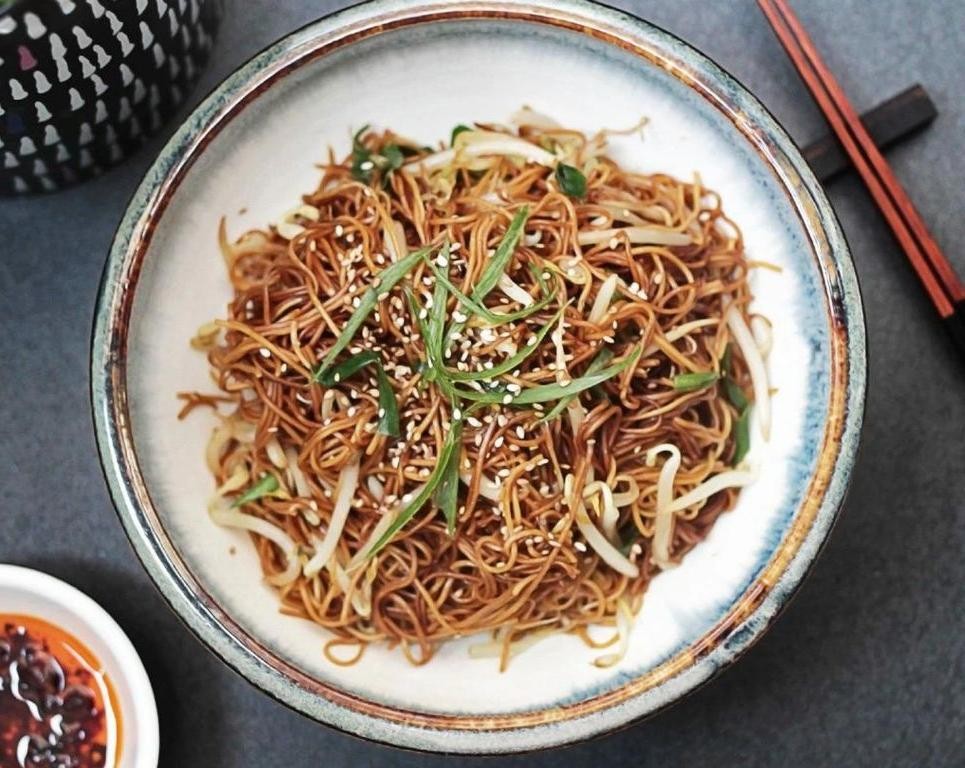
Dusk settles in, and the kitchen becomes a sanctuary where simple ingredients transform into comforting meals. Tonight, it’s about weaving together the humble yet vibrant flavors of hibachi noodles, egg, and bean sprouts into a dish that feels both nourishing and indulgent.
Ingredients
- 8 oz hibachi noodles (I love the slight chewiness they bring to the dish)
- 2 tbsp extra virgin olive oil (my go-to for its fruity notes)
- 2 large eggs, room temperature (they blend more smoothly when not cold)
- 1 cup bean sprouts (for that irresistible crunch)
- 1 tbsp soy sauce (adds depth and a touch of umami)
- 1/2 tsp garlic powder (a quick flavor boost)
- Salt to taste (though I’m careful not to overdo it with the soy sauce already in play)
Instructions
- Bring a pot of water to a rolling boil and cook the hibachi noodles according to package instructions, usually about 3-4 minutes, then drain and set aside.
- Heat the extra virgin olive oil in a large skillet over medium heat until shimmering, about 1 minute.
- Whisk the eggs in a bowl, then pour into the skillet. Let them sit for 30 seconds before gently stirring to create soft curds.
- Add the bean sprouts to the skillet, stirring occasionally, until they’re just softened, about 2 minutes.
- Toss in the cooked noodles, soy sauce, and garlic powder, stirring everything together until well combined and heated through, about 2 more minutes.
- Season with a pinch of salt if needed, then remove from heat.
Zesty and satisfying, this dish plays with textures—silky noodles against the crisp bean sprouts, all tied together with the richness of egg. Serve it straight from the skillet for a cozy, shareable meal, or top with a sprinkle of green onions for a fresh contrast.
Hibachi Noodles with Lamb and Eggplant
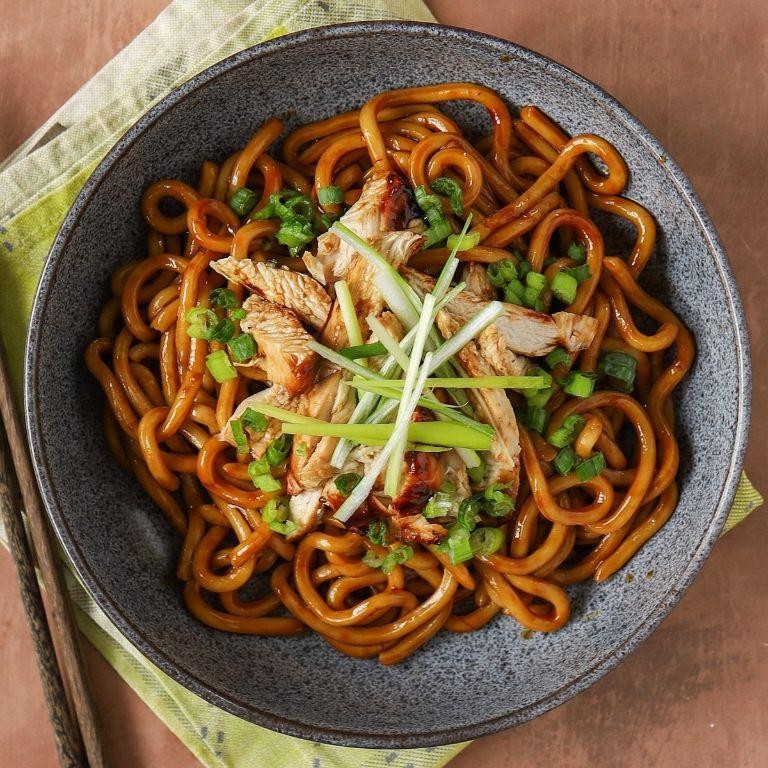
Just like the quiet moments before dawn, this dish brings a comforting warmth that slowly fills the room, a blend of savory lamb and tender eggplant intertwined with the delicate strands of hibachi noodles.
Ingredients
- 8 oz hibachi noodles – I love the slight chewiness they bring to the dish.
- 1 lb lamb, thinly sliced – Opt for shoulder cuts for their perfect fat-to-meat ratio.
- 1 medium eggplant, cubed – About 2 cups, soak in salted water to remove bitterness.
- 2 tbsp extra virgin olive oil – My go-to for its fruity notes.
- 3 cloves garlic, minced – Freshly minced makes all the difference.
- 1 tbsp soy sauce – For that umami depth.
- 1 tsp sesame oil – A little goes a long way.
- 1/2 tsp red pepper flakes – Adjust based on your heat preference.
- 2 eggs, room temperature – They blend better when not cold.
Instructions
- Bring a large pot of water to a boil and cook the hibachi noodles according to package instructions, usually about 3-4 minutes. Drain and set aside.
- Heat olive oil in a large skillet over medium-high heat. Add the lamb slices and cook until browned, about 3 minutes per side. Remove and set aside.
- In the same skillet, add the eggplant cubes. Cook until they start to soften, about 5 minutes, stirring occasionally.
- Push the eggplant to one side of the skillet. Crack the eggs into the other side and scramble until just set, about 1 minute.
- Add the garlic, soy sauce, sesame oil, and red pepper flakes to the skillet. Stir everything together and cook for another minute.
- Return the lamb to the skillet along with the cooked noodles. Toss everything together until well combined and heated through, about 2 minutes.
Combining the silky noodles with the rich lamb and creamy eggplant creates a dish that’s both hearty and nuanced. Serve it with a sprinkle of green onions for a fresh contrast, or enjoy it as is for a deeply satisfying meal.
Vegan Hibachi Noodles with Seitan
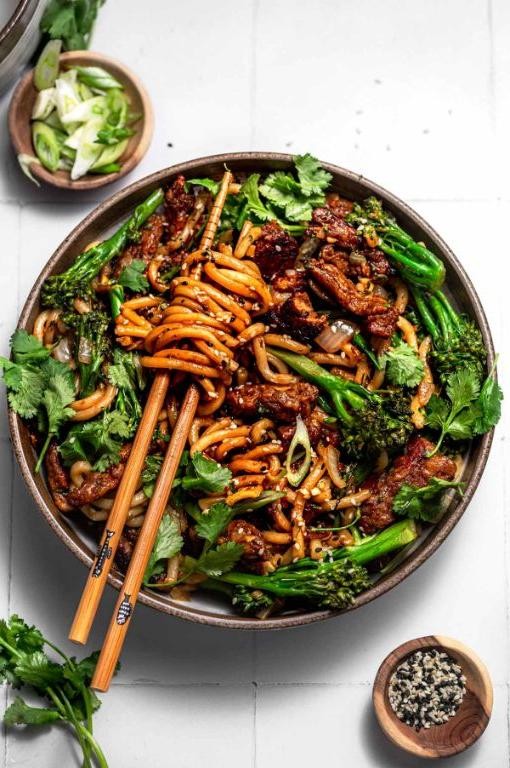
Perhaps it’s the simplicity of stir-frying that brings me back to this dish time and again, or maybe it’s the way the seitan crisps up just so, offering a satisfying chew amidst the soft noodles. Whatever the reason, this vegan hibachi noodles recipe has become a comforting staple in my kitchen, especially on evenings when the light fades slowly and the air carries a hint of nostalgia.
Ingredients
- 8 oz dried udon noodles – I find the thickness of udon perfect for holding onto the sauce.
- 2 tbsp sesame oil – A must for that authentic hibachi flavor.
- 1 cup seitan, sliced into thin strips – The heartier, the better here.
- 1 tbsp minced garlic – Because what’s stir-fry without garlic?
- 1 tbsp minced ginger – Freshly minced ginger adds a zing that powdered just can’t match.
- 2 tbsp soy sauce – I opt for low-sodium to control the saltiness.
- 1 tbsp maple syrup – A touch of sweetness balances the savory.
- 1 cup mixed bell peppers, thinly sliced – For color and crunch.
- 1/2 cup sliced onions – They caramelize beautifully.
- 1 tbsp vegetable oil – For that high-heat sear.
Instructions
- Bring a large pot of water to a boil and cook the udon noodles according to package instructions, usually about 8-10 minutes. Drain and set aside.
- Heat sesame oil in a large pan over medium-high heat. Add seitan strips and cook until edges are crispy, about 5 minutes. Tip: Don’t overcrowd the pan to ensure each piece gets crispy.
- Push seitan to one side of the pan. Add vegetable oil, garlic, and ginger to the other side, sautéing for 30 seconds until fragrant.
- Add bell peppers and onions to the pan, stir-frying for 3-4 minutes until vegetables are tender but still crisp.
- Mix in the cooked noodles, soy sauce, and maple syrup, tossing everything together until well combined and heated through, about 2 minutes. Tip: Use tongs for easier mixing.
- Serve immediately. Tip: Garnish with sesame seeds for an extra touch of texture and flavor.
With each bite, you’ll notice the noodles are delightfully chewy, the seitan robustly flavored, and the vegetables adding a fresh contrast. Try serving it with a side of pickled ginger to cut through the richness, or atop a bed of steamed greens for an extra nutrient boost.
Hibachi Noodles with Crab Meat and Corn

Yesterday, as the evening light faded, I found myself craving something that balanced comfort with a touch of elegance. That’s when the idea of Hibachi Noodles with Crab Meat and Corn came to mind, a dish that’s as much a feast for the eyes as it is for the palate.
Ingredients
- 8 oz hibachi noodles – I love how their chewy texture holds up to stir-frying.
- 1 cup fresh crab meat – Always opt for fresh if you can; it makes all the difference.
- 1/2 cup corn kernels – Frozen works in a pinch, but fresh off the cob is sublime.
- 2 tbsp soy sauce – My pantry staple for that umami kick.
- 1 tbsp sesame oil – Just a drizzle adds a nutty depth.
- 2 cloves garlic, minced – Because what’s a stir-fry without garlic?
- 1 tbsp butter – Unsalted, so you can control the seasoning.
- 1/4 tsp red pepper flakes – For a gentle heat that lingers.
Instructions
- Bring a large pot of water to a boil and cook the hibachi noodles according to package instructions, usually about 3-4 minutes. Tip: Stir occasionally to prevent sticking.
- While the noodles cook, heat a large skillet over medium heat and melt the butter. Tip: Keep the heat medium to avoid burning the butter.
- Add the minced garlic and red pepper flakes to the skillet, sautéing for about 30 seconds until fragrant. Tip: Don’t let the garlic brown; it should just release its aroma.
- Drain the noodles and add them to the skillet, tossing to coat in the garlic butter.
- Stir in the soy sauce and sesame oil, ensuring the noodles are evenly seasoned.
- Gently fold in the crab meat and corn, heating through for about 2 minutes. The crab should just warm, not cook further, to retain its tenderness.
On the plate, this dish is a harmony of textures—the noodles’ chewiness against the crab’s delicate flakes and the corn’s sweet pop. Serve it with a sprinkle of green onions for a color contrast that’s as pleasing as the flavors are deep.
Hibachi Noodles with Teriyaki Sauce and Sesame Seeds
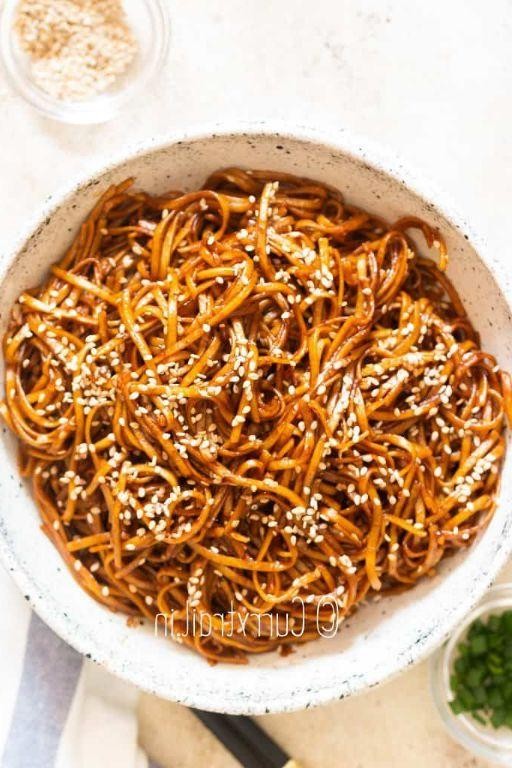
Perhaps it’s the gentle sizzle of the noodles hitting the hot pan or the sweet aroma of teriyaki sauce that makes this dish a comforting favorite. There’s something undeniably soothing about preparing Hibachi Noodles, a dish that brings the vibrant energy of Japanese teppanyaki right into your kitchen.
Ingredients
- 8 oz dried udon noodles – I love the chewy texture they bring, perfect for soaking up the sauce.
- 2 tbsp vegetable oil – A neutral oil that lets the other flavors shine.
- 1/2 cup teriyaki sauce – Homemade or store-bought, this is the soul of the dish.
- 1 tbsp sesame seeds – Toasted, for that nutty crunch.
- 2 green onions, thinly sliced – They add a fresh, sharp contrast to the rich sauce.
Instructions
- Bring a large pot of water to a rolling boil over high heat. Add the udon noodles and cook according to package instructions, usually about 8-10 minutes, until al dente. Tip: Stir occasionally to prevent sticking.
- While the noodles cook, heat the vegetable oil in a large skillet over medium-high heat. Once hot, add the drained noodles. Tip: The oil should shimmer but not smoke.
- Pour the teriyaki sauce over the noodles, tossing gently to coat evenly. Cook for 2-3 minutes, allowing the sauce to thicken slightly. Tip: Use tongs for easy tossing.
- Sprinkle the sesame seeds and green onions over the noodles, giving one final toss to distribute them throughout.
Ready to serve, these noodles boast a delightful contrast between the silky sauce and the crisp vegetables. For an extra touch, serve them on a warm plate to keep the flavors vibrant and inviting.
Conclusion
Feast your eyes on these 18 mouthwatering hibachi noodle recipes, perfect for any gathering or cozy night in. Whether you’re craving something savory, sweet, or spicy, this roundup has you covered. Don’t just drool—dive in and try these dishes yourself! Share your favorites in the comments and spread the love by pinning this article on Pinterest. Happy cooking!
